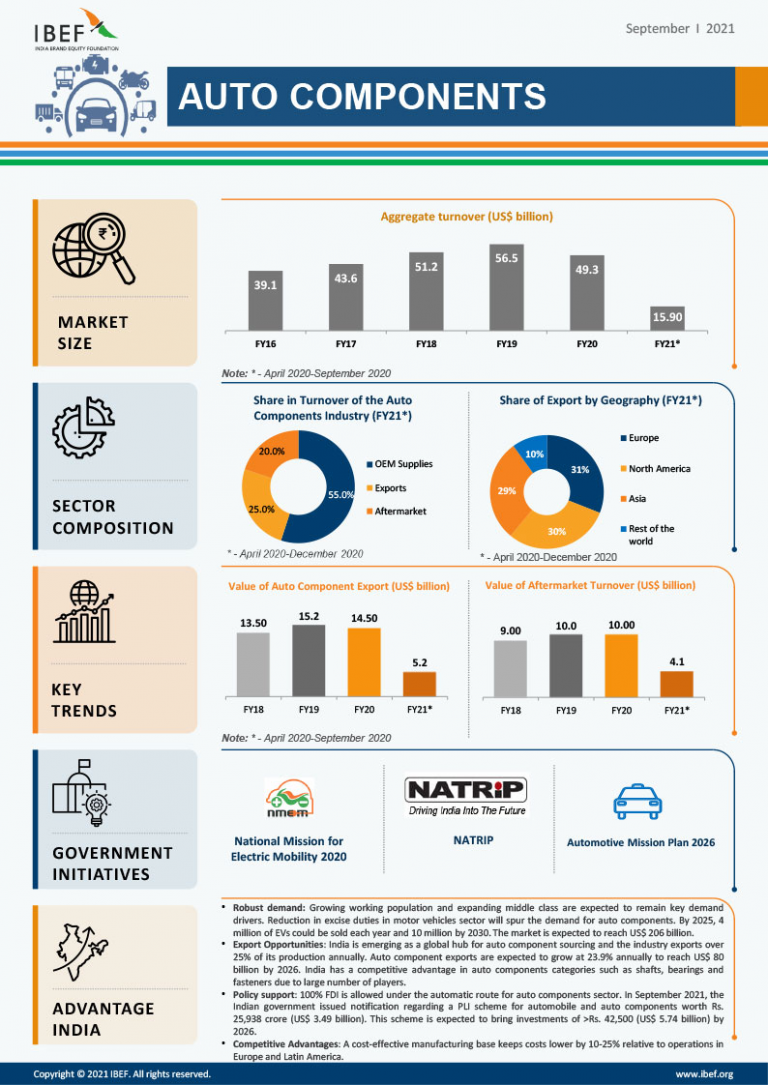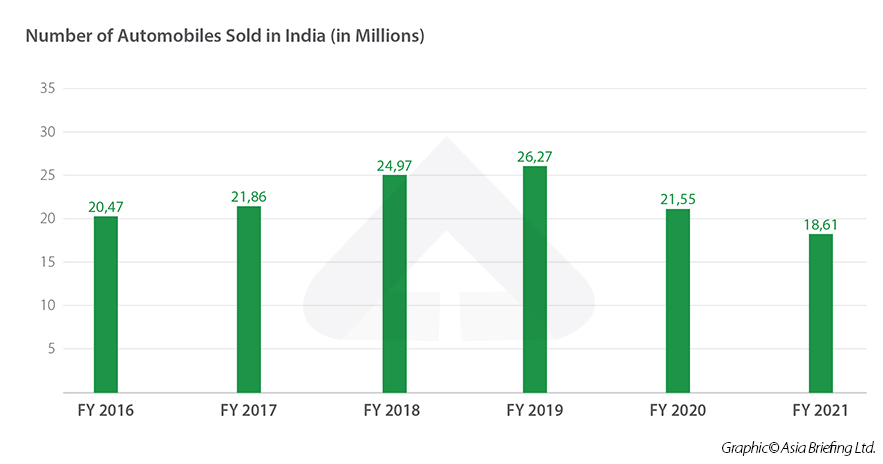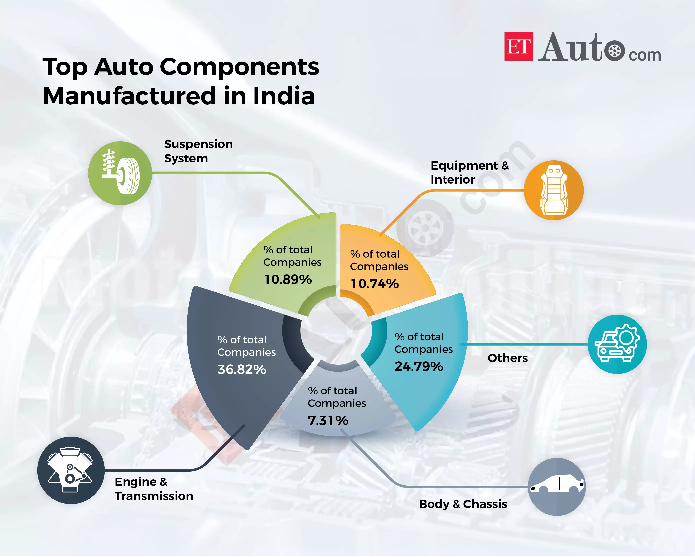Destination India – Why is India a Lucrative Market for Foreign Automotive Suppliers
Indian Automotive Market is the 4th largest automotive market in the world. It is the World’s largest automotive market for Two-wheelers, Three-wheelers, and Tractors manufacturing and the second largest market for Bus manufacturing.
Growth indicators
India’s $118 bn automobile industry in 2020 is expected to reach $300 bn by 2026. As of FY2020, 26.36 Mn vehicles were manufactured in the country, 80% of which are two-wheelers and passenger cars. Numbers crunched by a UK-based research firm indicate that a car is manufactured in India every 8.6 minutes. Two-wheelers still dominate the Indian market in terms of volumes owing to the growing middle class and a young population.
As the country embraces sustainability goals fervently, the EV market is expected to grow at a CAGR of 44% between 2020-2027 and is expected to clock 6.34 Mn unit annual sales by 2027. Growing penetration of electronics, enhanced safety features, greater fuel efficiency, stringent emission norms, and e-mobility are the key trends impacting the industry.

Home to Global R&D Centres
India is gaining momentum as a player for Global Technology Centres (GTCs). Car majors from across the world are ramping up their production facilities in India to serve the domestic and export markets. They have also been investing in R&D to tap into India’s acclaimed IT and engineering prowess. India already boasts of 30 automotive R&D centers, 85% of which have headquarters in Europe. This growth in GTCs has been mainly a result of cost efficiencies due to the lower cost of labour. However, with the ongoing disruption in the auto industry, R&D in India is also veering towards innovation and cutting-edge ideas going beyond mere cost effectiveness. As a result, foreign suppliers for components and for vehicles are localising the decision making.
As an enabling force, the Indian government is promoting and incentivising R&D, manufacturing and exports on a front footing. NATRIP, AMP 2016-26, NEMMP 2020 and PLI Schemes are the main initiatives that encourage, support, and incentivise the automotive sector with the aim to catapult the Indian automobile industry to the Global Top 3 in terms of engineering, manufacturing, and export of vehicles and auto components.
Geopolitical Impact
Global angst about China’s disregard for a rule-based international order and its recent crackdown over tech giants to control citizen data are actions that have sent shivers down the spine of global companies. India is seen as a balancing power in Asia and companies have begun actively de-risking their businesses from China’s dominance. Japan offers subsidies to its companies to move production to other SE Asian countries. The Quad alliance of Japan, US, Australia and India as well as the Supply Chain Resilience Initiative (SCRI) between Japan, Australia and India are all policy measures and multilateral partnerships to counter China. India stands at a critical juncture as the world re-balances the current state of affairs.
The PLI scheme of Indian government for the manufacturing sector has started picking up in the last year. Exports from India have seen a big rise since the covid restrictions were lifted.

Estimates, Facts and Figures
According to data from SIAM, India’s total auto exports in the first quarter of fiscal 2021-22 (Q1, from April to June) was 1.4 million units, over three times the figure in the same period in the previous year. Two-wheeler manufacturers saw an especially large boost, exporting about 1.1 million units in this period, compared to 337,983 units a year ago. As the chart on the left depicts, the numbers are steadily rising to meet and overtake pre-covid levels – as can be seen from the dips through Covid and rising numbers in the 1st Quarter of FY22.
As mentioned earlier, Industry estimates the Indian automobile sector to reach US$300 billion by 2026 from the existing US$118 billion in 2020. Currently, the automotive sector contributes 7.1 percent to India’s GDP and employs a workforce of 37 million. The Automotive Mission Plan 2016-26 (AMP) envisages raising the sector’s share in GDP to 12 percent and creating employment opportunities for over 65 million people. Domestic vehicle sales for Quarter 1 of FY22 have witnessed a 113% growth over the FY21 quarter.
Harbinger of recovery – The EV Revolution
Persistence of the government for transition to cleaner mobility in India including the recently announced PLI Scheme to boost both manufacturing of EVs, Hydrogen fuel cell vehicles as well as Advanced Chemistry Cells for EV Batteries are likely to augur well for the automotive market. Electric vehicle sales and especially e-two-wheelers are likely to witness positive sales throughout FY22. According to an independent study by CEEW Centre for Energy Finance (CEEW-CEF), the EV market in India will be a US$206 billion opportunity by 2030.

Status of Auto components
According to AMP 2016-26, India is expected to emerge as the 3rd largest automotive market in the world in terms of volume by 2026, after China and the USA.
The Indian auto component industry is a critical part of the original equipment manufacturer (OEM) value chain and has grown at a healthy pace over the past few years. As per data from a report by CARE Ratings, in terms of segment-wise share in OEM supplies, the passenger vehicles segment is the largest with 45.3 percent share, followed by two-wheelers (19.6 percent share), medium and heavy commercial vehicles (12.4 percent share), LCVs (11.8 percent share), tractors (6.5 percent share), three-wheelers (3.3 percent share), and construction equipment (1.1 percent share).
Among key challenges faced by Indian component manufacturers is the low-level of technology penetration and negligible R&D capacity. According to an ICRA report released in September 2021, while the long-term growth drivers look resilient, short-term challenges like commodity inflation and semiconductor shortage persist.
Final word
According to a joint report by ACMA and PwC on India’s automotive component industry, uncertainty and volatility are now the new normal. Tariffs, trade wars, and economic uncertainty will continue to have an impact. Meanwhile, the underpinnings of the business model that has sustained the automotive industry for more than 100 years are undergoing some of the biggest changes. The future of mobility will be characterised by CASE (connected, electric, automated, shared) disruption, leading to a significant shift in industry profit and revenue pools for traditional industry players. Automotive suppliers will need to change their operating model in order to be agile, flexible and customer-focused, and succeed in this environment.
As the CXO of a leading automotive supplier company puts it “Never miss out on investment opportunities with confirmed customers. Believe in India’s growth story”
To know more about opportunities in the Indian Automotive Market contact me at sudhir.nerurkar@quanzen.in




